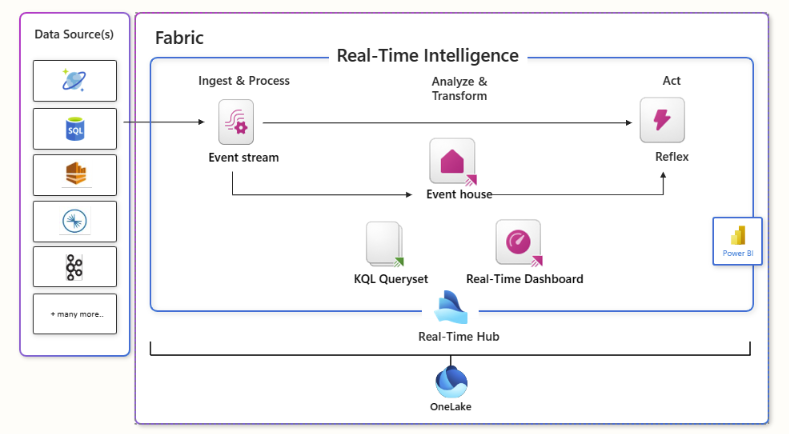Real-time analytics & Microsoft Fabric’s new capabilities
Introduction
It has been argued in the past that Real-Time Analytics and Reporting only has a small part to play in business intelligence. This is due to the view that it is only useful when the priority is processing data in real time and there is a requirement to act in real time. However, this is not wholly accurate. This powerful tool empowers organisations of all sizes to make informed decisions quickly, leading to cost savings, increased efficiency and improved customer experiences.
Why real-time analytics matters
Today’s competitive landscape demands agility. Thankfully, advancements in real-time analytics and the value and accessibility for organisations to make decisions and take action quickly has increased significantly over time, giving them the power to stay ahead of the curve.
The surge in real-time analytics is due to two keys trends: advancing business structures and technology innovation. Businesses now have the ability to process and analyse data in real time, but also automate the action tasks that drive the value.
Imagine, a retailer needing to re-order stock of a product because it is selling really well. Thanks to real-time analytics, the technology now means they can instantly understand how much stock needs to be ordered and automatically reorder from a supplier. Completing the order can now be automated and instantaneous. Saving time, reducing costs and increasing revenue.
Therefore, integrating real-time analytics capabilities into your organisation is a strategic move, and an opportunity that is available to everyone. Microsoft’s new Real-time intelligence service in Fabric makes the process even more simple. The new announcement of Real-Time Intelligence combines the capabilities of Synapse Real-time Analytics and Data Activator to replace the Synapse Real-time intelligence workload. This enhancement contains a set of tools for all your Real-Time analytics needs all in one place within the Fabric ecosystem. These tools give you the ability to ingest, analyse, store, report and most importantly create automated actions from your real-time data.
These full set of services are within the Real-Time Intelligence workload:
Event Stream – the ingestion point where you can utilise a range of connectors to start steaming high volumes of data from the source, shape data and route events.
Event House – the analytics engine that processes the data through indexing and partitioning. It also acts as the storage location via event houses that can be accessed from OneLake. The data stored here is ready to be used across Fabric functionalities in order to source tools such as Kusto copilot.
Reflex (Data Activator) – start taking action based on what’s happening within your data. Reflex allows for real-time responses based off triggers or events that initiate activities such as alerts, notifications and workflow activities.
Real-Time Dashboard – an easy and quick way to create reports and start exploring and analysing streaming data. With the integration of Copilot, you can easily turn natural language questions into KQL.
KQL Queryset – KQL (Kusto Query Language) is language designed to allow for the exploration of structured, semi-structured and unstructured data. A queryset is a collection of queries that allows you to save queries in a central place and easily execute, modify and visualise the results.
Real-Time Hub – a central location to manage access, analysis and sharing of real-time-data. It provides the view of artefact within the workload such as the current data streams, the connected data sources as well as the active events.

What Does This Mean For You?
1. Instantaneous Data Processing
Microsoft’s Fabric Platform simplifies real-time intelligence, you can connect to and stream data instantaneously. This means that as data flows into the system, transformation is immediate. This enables you to react to new information without delay.
2. Seamless Integration across Fabric
With a unified platform you can easily source live data streams to other Fabric workloads, enabling more dynamic and responsive dashboards, reports, and applications that can be utilised across the business.
3. Enhanced Data Analytics and Insights
Real-time intelligence is not only about speed; it is also about depth of insights. The access to algorithms and AI capabilities through Fabric that can now operate on live data, providing deeper and more intelligent insights. This enables you to identify trends, anomalies, and opportunities as they happen, leading to more informed and timely decision-making.
4. Scalability and Flexibility
Fabric’s architecture ensures that real-time intelligence can scale according to your needs. Whether dealing with a few hundred data points per second or millions, the platform is designed to handle varying loads efficiently. This flexibility ensures that businesses of all sizes can benefit from real-time analytics without compromising on performance or accuracy.
Conclusion
The release of Real-Time Intelligence to Fabric provides a clear and easier route to how you can start analysing live data. By enabling live data processing and analysis, it empowers you to make quicker, more informed decisions, ultimately driving growth and innovation. As this Real-Time capability fully integrates across the Fabric platform if you’re already considering or using Fabric it is a great opportunity to try real-time analysis as it’s already accessible to you.
Are you ready to start using Microsoft Fabric? Great news! Real-time analysis is seamlessly integrated and readily available. Get in touch via our Live Chat to learn about unlocking the power of real-time insights for your business.


